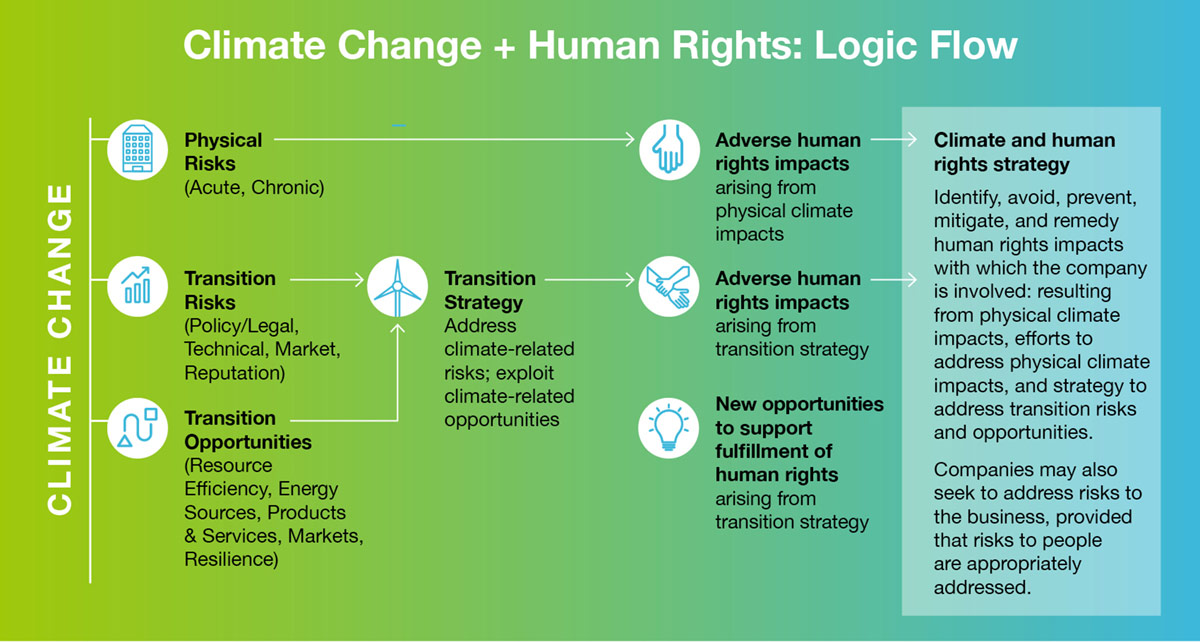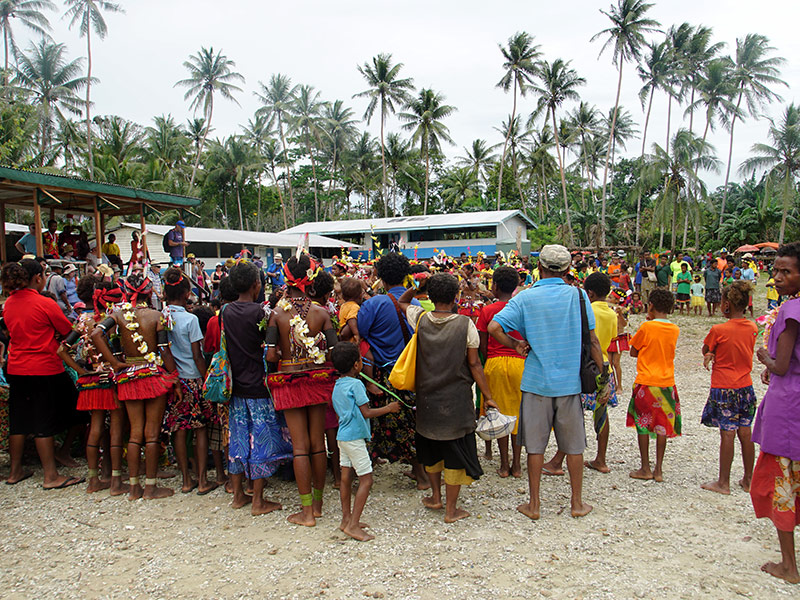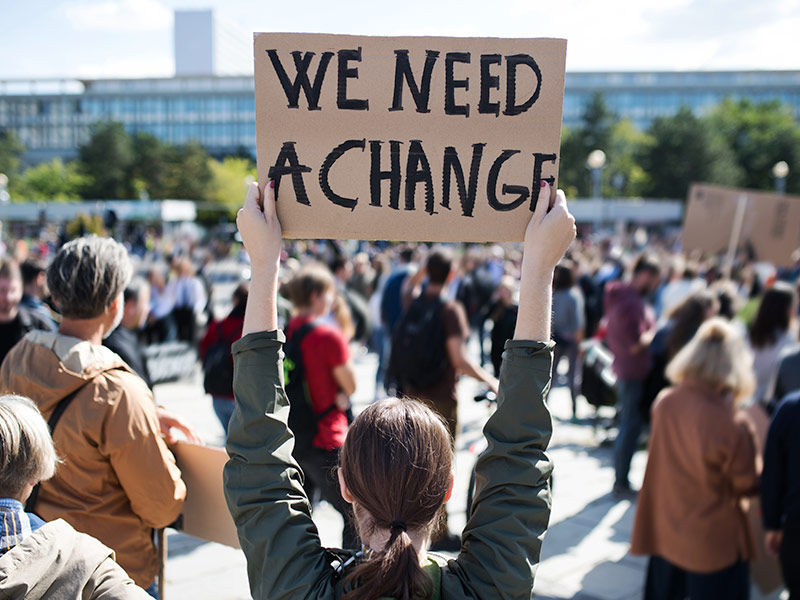
Risks related to physical climate impacts
Physical climate impacts include “acute” shorter-term risks (such as extreme weather events, flooding, and drought) and “chronic” longer-term risks (such as changes in agricultural patterns and the spread of vector-borne diseases). Both types of physical impacts affect business operations and supply chains—such as damage to infrastructure, disruption of logistics and communications, and worker productivity and attendance. They also can affect the communities in which businesses operate, including damage to homes, schools, agriculture, and food sources, exacerbating vulnerabilities communities may already face. While there are similarities across different countries, underlying societal inequalities are often contextual and manifest differently across geographies.
Risks related to the transition to a low-carbon economy
To hold global warming to the agreed-upon warming level of 1.5 degrees Celsius and minimize climate impacts, the world must transition to a net zero greenhouse gas (GHG) emissions economy by 2050. The systemic change necessary will require all stakeholders—governments and businesses alike—to contribute to a just transition. This transition has the potential to create 65 million new jobs and US$26 trillion in economic opportunities in the next ten years. However, failure to consider human rights impacts of the transition could also add to significant job displacement and new migration patterns that bring novel human rights challenges.
Furthermore, the transition to renewable energy is already leading to an increase in demand for minerals, used to power everything from solar panels to ion-batteries and electric vehicles. The extraction and sourcing of many of these minerals are associated with armed conflict and human rights abuses as well as threats to human rights defenders.
Managing the human rights impacts as we transition away from using fossil fuels to low- or zero- emissions sources, such as renewable energy, will be critical as there is a risk that some workers and communities could be left behind or have their rights undermined.
As the connection between climate change and human rights impacts becomes more widely acknowledged, companies are increasingly being held accountable for failing to meet their human rights responsibilities. The responsibility to respect human rights pertains to every company, regardless of industry, size, or geographic location. However, the human rights impacts they will need to address will vary from industry to industry and company to company. Understanding how each company or industry is connected to human rights harms is essential to developing sustainable, rights-respecting transition plans.
A Changing Landscape
While we know that climate impacts will increase, how and where climate impacts manifest is extremely uncertain. To adequately prepare for and address these impacts in an uncertain future, business should use a foresight-driven approach to factor the changing macro context into the design of robust policies, strategies, and programs. This includes considering early stage “signals of change,” which could mature in ways that will require rethinking approaches to address climate change and human rights challenges. For example:
- Climate litigation targets business: Between 2017 and 2020, climate litigation globally doubled. Cases are increasingly targeting corporate entities.
- Climate refugees: In January 2020, the United Nations Human Rights Committee ruled that it is unlawful for governments to return people to countries where their lives might be threatened by the climate crisis.
- Growing vulnerabilities of the precariat: COVID-19 has left gig economy workers and the informal labor sector highly vulnerable. These risks will be amplified with more frequent climate-related disruptions.
- Emergency surveillance: Vaccine certificates and tracking apps are being launched to host individuals’ health or vaccination status and permit access to everything, from international travel to their workplace. As governments struggle to contain COVID-19, many will face mounting pressure to bypass privacy and restrict civil liberties as they attempt to control and end the pandemic. Temporary abrogations may become permanent. Crises such as the COVID-19 pandemic will only become more frequent with climate change, and profound disruptions caused by climate impacts will intensify questions about the best balance between individual liberties and collective security.
- The link between climate change and gender-based violence: Climate-related disasters are exacerbating gender inequality and is leading to increases in incidences of gender-based violence.
- Dirty supply chains powering clean energy: Infrastructure and technologies needed to power the transition to a low-carbon future depend on complex supply chains with problematic social and environmental impacts.
- The data deficit for AI and climate change: AI and big data will be essential to mitigate climate impacts and improve resilience. However, in developing countries, there is often a lack of data generation and poor data collection and/or management practices, resulting in a data deficit.
- The rights of nature: To protect their rivers from pollution, encroachment and illegal dredging, some countries have granted certain rivers the legal status of living entities. This has raised questions about how to balance human rights with environmental rights as the concept of “environmental personhood” gains traction, and rivers, lakes, mountains, etc., are granted the same rights as people.
To adequately prepare for and address these impacts in an uncertain future, business should use a foresight-driven approach to factor the changing macro context into the design of robust policies, strategies, and programs.
Developing a Resilient Response
The emerging issues above could manifest in a variety of ways, depending on the industry and how the global economy and international geopolitical environment evolve over time. To build resilient strategies that address and mitigate the human rights harms associated with the climate impacts of business operations and strategic climate initiatives, companies will need to embed responses to key risks and opportunities that consider the emerging future. BSR’s research identified five strategic “hotspots” with the potential to create adverse human rights impacts that companies should consider as they build out their strategies.
- Disruption and shifts in the value chain will lead to new vulnerabilities for business and workers.
- Automation will lead to efficiency gains as well as questions around the future of work.
- Data collection will become increasingly widespread.
- Precarious employment situations will lead to considerable risks related to the rights of workers and worker protection.
- Shifts in the reporting landscape will lead to new and/or evolving regulations and standards on human rights reporting practices and policies.
Recommendations
By taking these signals of change and strategic “hotspots” into consideration, companies can begin to prepare for adverse climate and human rights impacts across their value chains. To create long-term, resilient business strategies, companies should:
Expand each advancement to learn more.
Companies have a responsibility to identify and address the adverse human rights impacts arising from the physical climate impacts of their business operations and the impacts associated with their transition plans. To appropriately fulfill this responsibility, companies should integrate a human rights-based approach to their climate work by consulting with impacted rightsholders, identifying potential adverse human rights impacts arising from their business operations and climate strategies, and taking action to address these impacts. This may require changes to individual company approaches, along with collaborative, industry-based initiatives that put human rights at the center of climate strategy. The following recommendations lay out the first step to tangibly making those shifts.
In order to build effective resilience strategies that take into account both climate change and human rights, companies must understand how climate vulnerabilities manifest across their value chains—both in terms of those directly impacted by the company’s response to climate change as well as how certain populations may be independently affected by climate change in the areas or industry in which they work. This can be done by assessing the human rights impacts of climate change as part of existing risk assessment processes or through targeted risk assessments that evaluate specific aspects of the value chain (e.g., certain commodities or geographies). Integrating these considerations into existing processes can serve as a low-lift, first step to identifying risks at this intersection while building internal understanding on the relevance of climate and human rights impacts across teams.
While identifying the communities most affected by the climate crisis is the first step, engaging these communities in the identification, development, and implementation of solutions to build resilience to climate impacts is crucial. Affected communities need to be at the center of the conversations and solutions to both physical and transition impacts.
Risks must be managed both from the top and bottom of the value chain. At the top, solutions can involve Enterprise Risk Management (ERM) systems and secure buy-in from C-suite leadership and decision-makers in regional/local offices. Simultaneously, at the bottom of the value chain, perhaps at the farm or factory level, resilience programs and risk assessments can be deployed in a way that can reach those most affected on the ground.
The intersectionality of climate change and human rights is still a nascent concept for business. As advocates continue to integrate this concept into their approaches, companies can help build awareness and provide space for those most affected by the climate crisis to contribute to the conversation. Furthermore, companies can use their influence to call on all levels of government to integrate a human rights and equity lens into their climate solutions, and vice versa.
Internally, teams spearheading the consideration of climate and human rights can host workshops and trainings to convene colleagues and explore synergies between departments. Externally, collaboration may involve establishing partnerships with experts and civil society organizations to create holistic strategies that tackle the human rights impacts of climate change. Companies can also participate in collective commitments, such as the Business Pledge for Just Transition and Decent Green Jobs.
To understand how a business and its stakeholders may be affected, companies should develop an understanding of a myriad of future scenarios, influenced by climate change, human rights, and other social, economic, and political dimensions. Companies can test the resilience of their strategies or approaches against these scenarios and ensure that they are appropriately addressing the climate and human rights impacts that may arise. This can be done as part of a climate scenario analysis exercise in line with the TCFD Recommendations.
Identifying common metrics to measure the impacts and outcomes of climate change programs and activities on both business and society is helpful to drive action and obtain buy in on the work at this intersection.
Get the Report
{report_downloads_fr} {tmpvar_download_fr} {/report_downloads_fr}Let’s talk about how BSR can help you to transform your business and achieve your sustainability goals.
{tmpvar_you_might_also_like_fr}







